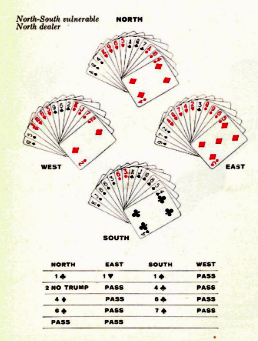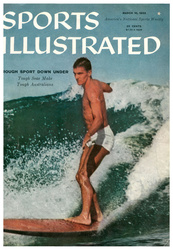In writing about bridge, as in playing it, I am happy to acknowledge a debt to an 84-year-old youngster whose long string of championship victories spanned three generations of the game—whist, auction and contract. I refer, of course, to my friend Sidney Lenz, the Grand Old Man of bridge. He was the first to write about many of the plays that have since become standard. He is a sparkling raconteur, a high-ranking amateur at table tennis and a bewildering prestidigitator.
Such feats of magic as he produced as South, declarer in the play of the hand I am about to relate, had nothing to do with legerdemain—although the way he materialized the 13th trick from thin air appeared for all the world to be an optical illusion.
North/South Vulnerable. Dealer North
The auction would appear to add clairvoyance to Lenz’s many talents, since he bid the grand slam without an ace in his hand. But North’s bidding clearly revealed the three aces he needed, and South himself with his convenient void could take care of the first trick in hearts. So, when North got around to proclaiming his powerful spade support at long last, South decided to go for all the marbles.
West opened the play with the jack of hearts. South ruffed this trick and counted up the rest that could be easily won. The total came to 12—five spade tricks, six club tricks and the ace of diamonds. The 13th card that stubbornly remained to be taken care of was that extra little diamond in South’s hand.
Obviously, the grand slam could be made only if one of dummy’s trumps could take care of that losing diamond. However, since the laws of contract bridge are always the same for Mr. Lenz as they are for any ordinary player, there is a rather sticky little penalty to be paid for trumping a suit of which you are not void. At least three rounds of trumps would have to be drawn before South could safely discard dummy’s diamonds on his clubs—and by that time dummy would have no more trumps to use for ruffing diamonds. Nevertheless, Lenz did find a most useful and ingenious way to let dummy’s trump take care of his diamond loser.
No black magic was required. After ruffing the opening lead, a diamond to dummy’s ace let declarer trump another heart. Next, South cashed the king of spades and led a spade to dummy’s queen. A third heart was ruffed with South’s remaining spade, dummy got back with a club, and, while the ace of spades drew East’s last trump, it also took care of providing a parking place for South’s remaining diamond. The clubs were good for the rest of the tricks.
Extra trick: The play Lenz used to materialize the extra trick for his grand slam is called a “dummy reversal.” It seldom pays to use trumps in the long-trump hand for ruffing; except as this may establish a long suit in dummy, this play normally will not add any tricks to the total you are otherwise able to win. The exception is the one case illustrated here, where you are able to bring the long trump hand down to a holding of fewer trumps than the opposite hand began with and thereafter use what started to be the shorter hand for the purpose of drawing the adverse trumps.
Esta entrada también está disponible en: Spanish


